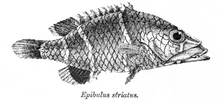Everting mouth wrasse
| Everting mouth wrasse | ||||||||||||
|---|---|---|---|---|---|---|---|---|---|---|---|---|

colored male |
||||||||||||
| Systematics | ||||||||||||
|
||||||||||||
| Scientific name | ||||||||||||
| Epibulus insidiator | ||||||||||||
| ( Pallas , 1770) |
The everting mouth wrasse ( Epibulus insidiator (ἐπίβουλος = insidiator "the sneaky")), already given the antiquated name "Erlister" early on, is one of the extreme forms of food acquisition among bony fish , although you can hardly tell at first.
It resembles other cheilinins in outline - only in front of the pelvic fins one can see a more noticeable deep fold as long as the fish swims calmly. But if it comes near a smaller prey (shrimp, fish), it can suddenly snap its very small mouth forward by 65% of the head length and suck in the victim. It only resembles the (even bigger-mouthed) cichlid Petenia , somewhat still the deep-sea fish Stylephorus , and very remotely a dragonfly larva (with a "trap mask"). Through the maxillary apparatus, many Teleostei (real bony fish) get something like a grasping extremity on the mouth (cf. crabs, cephalopods).
Surname
The English name slingjaw wrasse means roughly "sling mouth wrasse ". Longjaw wrasse is misleading (the intermaxillary is not long - the name was better suited to Gomphosus ). The Australian name is telescope fish , in French trompeur ("cheat"). The German name Stülpmaul is semantically incorrect, but has caught on .
description
The reef fish, which grows to just over 50 cm in length, is often colorful, variable in color (but not physiologically changing color ) and also sexually dimorphic in color. The species is protogynous (i.e. females can later become males). Young fish are brown, but soon get thin white stripes (picture). Later some become completely yellow ( xanthism ), others remain mostly brown or have yellow spots; the pectoral fins are often dark. Males (from about 25 cm) are dark (brown) with a white head (with a dark band through the eye), later mostly with yellow-red spots on the back or the like; Territoriality during spawning was observed. Several varieties have been described as "new species" (see figure). Epibulus brevis Carlson, Randall et Dawson 2008, however, is a real (second) species of the genus (established by Georges Cuvier in 1815).
- Fin formula : D IX – X / 9–11, A III / 8–9, P 12, C 11 (caudal fin round, but with extended corners; sometimes almost black, or lighter than the body).
- 20–23 lateral lines - cycloid scales (corresponding to the number of vertebrae).
- 46 or 48 chromosomes (diploid).
Jockstrap and maxillary apparatus (see fish mouth ): The head profile is saddled or hunched in front of the eyes. The lower jaw and premaxillary process (with rostral cartilage) are very long: almost to the rear edge of the skull; The stem of the pine, therefore, as with anchovies and many large-mouthed deep-sea fish, is directed caudoventrally (but the mouth is not large, as with Stylephorus ). The otherwise flat jockstrap is divided into narrow, mutually movable elements. The maxillary apparatus is activated (as is also the case in other cases) by lifting the upper skull (rotation against the spine). A (paired) ligament from the vomer to the interoperculare (the only significant “innovation”!) Pulls this and thus the quadratum and lower jaw forward; the premaxillary slides forward and the maxillary also swings forward, the mouth opens and becomes rounded. As soon as a “dead point” of the forward extension has been overcome, the neurocranium is lowered again. The protraction or protrusion is directed forward and slightly upward. The negative pressure of suction is generated in the usual way by transverse expansion of the oral cavity, splaying of the gill cover and lowering of the hyoid. The jaw teeth are weak (only a few slightly larger teeth in front; however, the pharyngeal bite is pinched). The folding of the “mouth tube” does not differ from that of other maxillary apparatus. It is interesting, however, that Epibulus likes to go to cleaner stations and have its "tube" cleaned inside and out, as the deep folds could allow foreign bodies or even parasites to penetrate. At first it was thought that the fish “shoots” like Toxotes . HC Delsman (1925) provided the first explanations of protrusion (the protrusion of the mouthpipe); the detailed functional analysis of the mechanism comes from Westneat and Wainwright (1989).
distribution
Epibulus insidiator lives near the substrate in the Indian Ocean ( Red Sea to South Africa) and the western Pacific (between southern Japan, Hawaii , Tuamotu and New Caledonia ) in reef lagoons and on outer edges (slopes, e.g. on the Great Barrier Reef ; up to about 40 m depth ), mostly single living; sometimes with drifting plant material on the way to neighboring islands (color as mimicry ?).
It is caught locally as edible fish (although possibly poisonous at times). There is a risk of overfishing as an eye-catcher for show aquariums.
Remarks
- ↑ , but not to be confused with the goldfish cultivated form of the same name and also not with Gigantura !
- ↑ cf. Günther and Deckert, several works in the 1950s, e.g. B. Malacosteus (1959), who throws the fang-toothed lower jaw forward and hits the prey from below.
- ↑ A similar development begins with Forcipiger longirostris according to LA Ferry-Graham, DI Botnick & PC Wainwright (2002): Using Functional Morphology to Examine the Ecology and Evolution of Specialization. Integrative and comparative biology 42: 265-277.
Individual evidence
- ^ BA Carlson, JE Randall and MN Dawson (2008): A new species of Epibulus (Perciformes: Labridae) from the West Pacific. Copeia 2008: 476-483
- ↑ Explanation of the mechanism see http://animaldiversity.ummz.umich.edu/site/resources/Grzimek_fish/structure_function/v04_id131_con_jawmech.jpg/view.html
- ↑ J. Morph. 202: 129-150
Web links
- Slippery mouth wrasse on Fishbase.org (English)
- Epibulus insidiator in the Red List of Endangered Species of the IUCN 2013.2. Posted by: To, A., Liu, M., Craig, M. & Rocha, L., 2008. Retrieved February 8, 2014.

